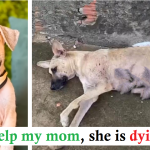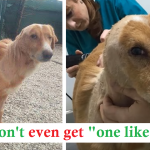A dog named Juanita had been left behind by her proprietor. She was found strolling the streets, her stomach swollen and fluid-filled. She was weak and having bother respiratory. Earlier than a great particular person got here alongside and took her to the veterinarian, individuals had been passing her and ignoring her predicament. The veterinarian acted straight away after recognizing the seriousness of Juanita’s situation.
She underwent many suctioning therapies to eliminate the fluid in her abdomen that was urgent on her lungs and making it laborious for her to breathe. Juanita was a warrior and, regardless of the severity of her situation, she slowly improved with every process.
Juanita began to disclose her precise self as she obtained stronger.
She was pleasant, playful, and her tail by no means stopped wagging. Juanita received the guts of the veterinarian and her staff, who took nice care of her.
They even managed to find her a foster residence the place she might heal in a comfy and caring setting. Juanita stored getting higher, and at last she was like earlier than. She was vibrant and vivacious.
She was given a perpetually residence with love and safety by her foster household, who fell in love together with her and determined to undertake her.
All those that heard Juanita’s narrative had been moved by it. She demonstrated that something is achievable with a bit of love and care, no matter how tough life turns into. From being an sick, deserted dog with no hope, Juanita turned a valued and adored member of a household. Her expertise served as a monument to the human spirit’s tenacity and the energy of affection.
Taking care of a dog’s hair involves several important steps to ensure their coat stays healthy and clean:
-
- Regular Brushing: Brushing your dog’s hair is crucial for removing loose fur, dirt, and debris, which can lead to mats and tangles if left unattended. The frequency of brushing depends on your dog’s coat type. Dogs with long hair, such as Golden Retrievers or Afghan Hounds, may require daily brushing to prevent matting. On the other hand, short-haired breeds like Beagles or Boxers may only need brushing a few times a week. Use a brush appropriate for your dog’s coat type, such as a slicker brush for long-haired breeds or a rubber curry brush for short-haired breeds.
- Bathing: Bathing your dog helps keep their coat clean and fresh-smelling. Use a dog-specific shampoo, as human shampoos can be too harsh and strip their skin of natural oils. The frequency of baths depends on your dog’s lifestyle and coat type. Dogs that spend a lot of time outdoors or have a tendency to get dirty may need baths more frequently than indoor dogs. However, over-bathing can lead to dry skin and coat, so aim for once a month unless your dog specifically needs more frequent baths.
- Trimming: Regular trimming is essential for preventing matting and keeping your dog comfortable. Pay attention to areas prone to matting, such as behind the ears, under the legs, and around the tail. You can use scissors or clippers to trim your dog’s hair, but be cautious not to cut too close to the skin, especially in sensitive areas. If you’re unsure, it’s best to seek the help of a professional groomer.
- Diet: A balanced diet is essential for maintaining a healthy coat. Look for dog foods that contain high-quality proteins, essential fatty acids, vitamins, and minerals. Omega-3 and omega-6 fatty acids, found in fish oil and flaxseed oil, are particularly beneficial for skin and coat health. Consult with your veterinarian to choose the best diet for your dog’s specific needs.
- Hydration: Proper hydration is vital for healthy skin and coat. Make sure your dog has access to clean, fresh water at all times. Dehydration can lead to dry, flaky skin and a dull coat.
- Regular Vet Check-ups: Regular visits to the veterinarian are essential for monitoring your dog’s overall health, including their skin and coat. Your vet can check for any underlying health issues that may affect your dog’s coat, such as allergies, skin infections, or hormonal imbalances.
- Supplements: In some cases, your vet may recommend supplements to support your dog’s coat health. Fish oil supplements are commonly recommended for their omega-3 fatty acids, which can help reduce inflammation and improve skin and coat condition. Other supplements, such as biotin or specialized skin and coat formulas, may also be beneficial depending on your dog’s specific needs.
- Environmental Considerations: Protect your dog’s coat from environmental factors that can damage it, such as extreme heat, cold, and harsh sunlight. Provide shade and shelter when outdoors, and consider using protective clothing or sunscreen for dogs with light-colored or thin coats. After outdoor activities, check your dog for ticks, burrs, or other debris that may have become lodged in their coat.
By following these detailed steps, you can ensure that your dog’s coat remains healthy, shiny, and free from common issues like mats, tangles, and dryness. Regular grooming and proper care are essential for keeping your furry friend looking and feeling their best!







